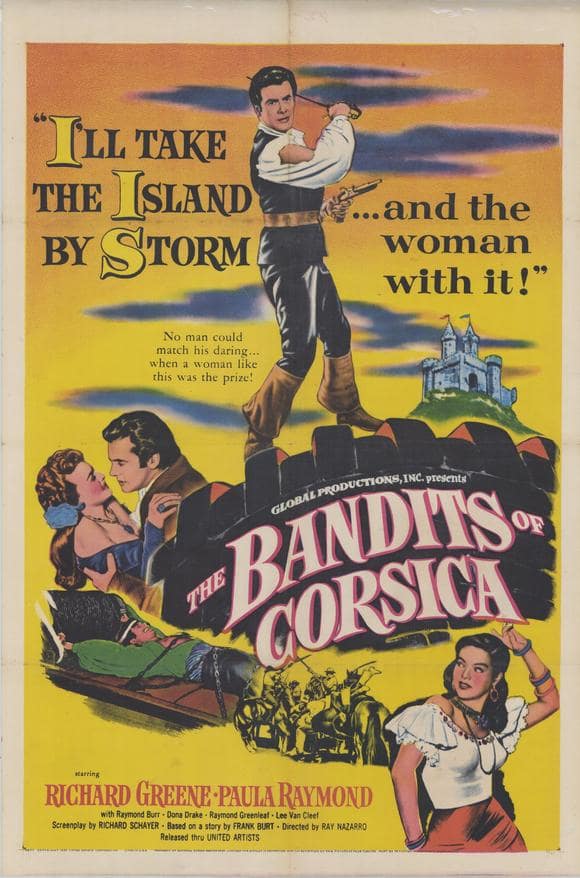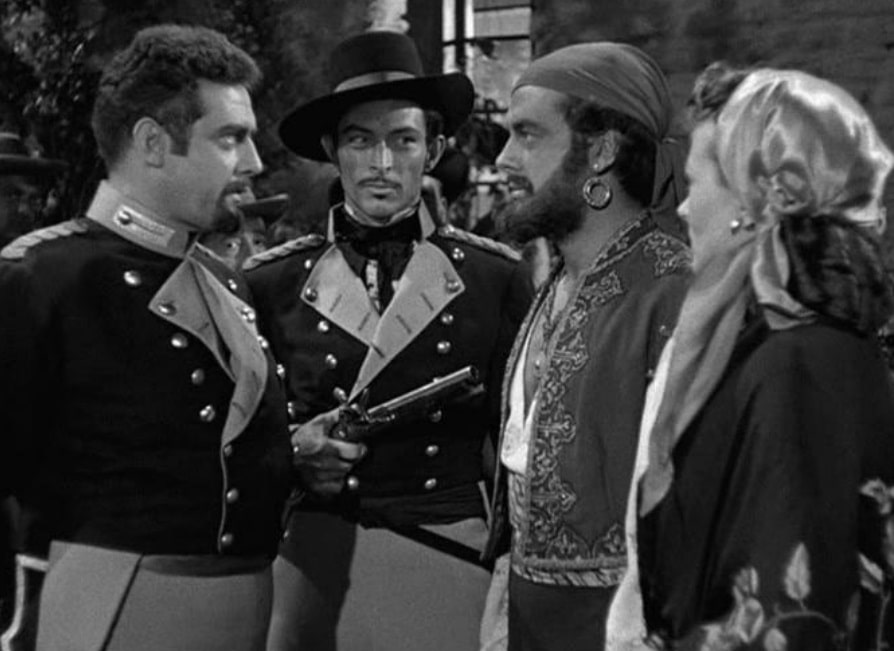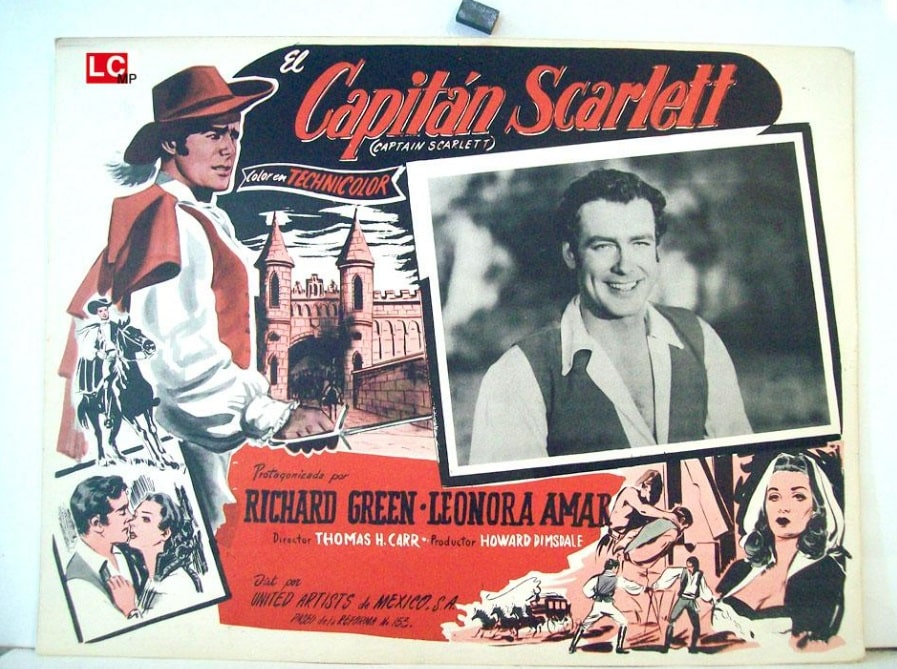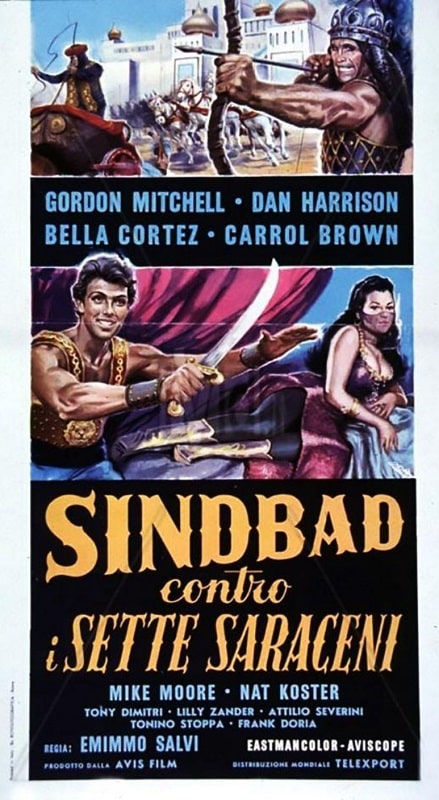Ellsworth’s Cinema of Swords: Banditti!
The Bandits of Corsica (USA, 1953)
After the turkeys we covered in the previous Cinema of Swords article, it’s good to get back to something fun, in this case three films about bandits and brigands. We watch these, of course, because bandits are basically land pirates, and everybody loves a good pirate movie! Sword-swinging, wise-cracking outlaw heroes are always welcome, especially when played by Richard Greene, the 1950s Robin Hood, learning the outlaw ropes here in two films that preceded his role in that classic TV series.
When I was rounding out this article by adding Ali Baba and the Seven Saracens, I realized to my shock that its review had somehow gotten overlooked and left out of the Cinema of Swords compilation coming your way from Applause Books next month. So, if you’re some kind of completist collector (like Black Gate’s esteemed editor, John O’Neill), bookmark this post and save it, as otherwise, your Cinema of Swords collection will be… incomplete!
The Bandits of Corsica (or The Return of the Corsican Brothers)
Rating: ***
Origin: USA, 1953
Director: Ray Nazarro
Source: Amazon Streaming Video
This overlooked film is often described as a remake of the 1941 Corsican Brothers, or as based on Alexandre Dumas’s short novel of that name, but it’s actually a full-fledged sequel that stands on its own. Producer Richard Small had done well with low-budget sequels to his Count of Monte Cristo, so he tried the same trick with his Corsican Brothers, and with some success. It’s strictly to Small’s by-then-familiar formula, drawing heavily on elements of its predecessor and from Small’s similar Son of Monte Cristo.
So, it doesn’t cover any new ground, but it’s pretty enjoyable nonetheless, thanks mainly to the charm and intelligence of its star, Richard Greene — the same actor who would make such an indelible impression later in the decade starring in the title role of the Adventures of Robin Hood TV show. In some ways, this film can be regarded as an extended screen test for that part, as its engaging and clever hero, the fugitive noble Mario Franchi, leads a band of outlaws in a desperate fight against tyranny.
But this is another of those double-lead-role swashbucklers, and Greene plays not just Mario Franchi but also his separated-at-birth twin brother Lucien, who, through his psychic connection to Mario, lives a tormented double life. Greene bases his tragic Lucien on Douglas Fairbanks, Jr.’s haunted performance in the 1941 Corsican Brothers and carries it off admirably.
Set five years after the earlier film, once again the Franchi brothers pit their doppelgänger hijinks against a ruthless aristocrat who wants to rule all Corsica, in this case Raymond Burr in the role of evil Baron Jonatto. Burr may not have the wicked gusto of Akim Tamiroff, the villain of the first film, or the urbane arrogance of George Sanders in Son of Monte Cristo, whom he’s clearly emulating, but he seems to be making an effort and is more lively than usual. Better is his brutal lieutenant, Nerva, played by a young but steely Lee van Cleef, who sneeringly steals the scenes from his stolid boss.
Count Mario has a comely but helpless countess (Paula Raymond), whose function is to be loved hopelessly by Lucien when she’s not being held captive by Jonatto. The plot is the standard mix of midnight raids, impersonations, abductions and escapes, villainous ultimatums, vows of vengeance, and a guards-oppressing-the-people montage, spiced with amnesia, Romany outlaws, a secret passage, and a dungeon torture chamber, all climaxing in a perfectly fine four-way sword fight. A well-worn tale, but solidly executed, and worth it for Greene and van Cleef.
Captain Scarlett
Rating: **
Origin: USA, 1953
Director: Thomas Carr
Source: Amazon streaming video
This bit of fluff is low-budget Saturday-matinee fare of interest solely because it stars Richard Greene, appearing here a couple of years before his run as Robin Hood in the fine 1955-59 Adventures of… TV series — in fact, he plays a hero similar enough to the bandit of Sherwood Forest that the film is almost a 72-minute audition for the role. This movie’s story is nominally set in “France, after the Napoleonic wars,” but the only thing French about it is some of the character names, and it bears no relation to actual history. Bad oppressive nobles are bad, good oppressed commoners are good, and Captain Scarlett, unjustly robbed of his estate, is back from the wars to put things right.
The film was shot in Mexico with a largely Latin American cast, and though the landscape looks even less like France than the usual southern California locations, at least the architecture is more-or-less European. The protagonists are Greene as Captain Scarlett, whose first name seems to be “Captain,” his sidekick Pierre DuCloux (Nedrick Young), another dispossessed gentleman, and Princess Maria (Leonora Amar), who has no more last name than Scarlett has a first.
The princess is being forced into a loveless marriage with a bad noble because he’s bad, and though Scarlett rescues her she isn’t very gracious about it. In fact, she spends most of the film being sullen and/or jealous, and the few scenes where she smiles and tries to be pleasant are unpersuasive. She’s supposed to be the hero’s reluctant love interest, but there’s zero chemistry between Maria and Scarlett, despite Greene’s considerable charm. Captain Scarlett was Amar’s last role in motion pictures, and it’s no wonder, really.
Greene, however, has what fun he can with the part of Scarlett, bounding around in a flowing red cape, tossing off clichéd heroic quips, and wielding a small-sword with dash in half-a-dozen duels. The frequently embarrassing script was written by producer Howard Dimsdale, so presumably director Thomas Carr didn’t have much leeway to tinker with it, and he and the cast just do the best they can. Virtuous peasants are saved from brutal and lecherous tax collectors, an execution by guillotine is duly foiled, and about every ten minutes there’s another thunderous chase on horseback through the Mexican hills.
There’s a brief departure from formula when Princess Maria, on the feeblest of pretexts, joins Scarlett and DuCloux to become a third freedom fighter, but it lasts only as long as the middle act before she falls off her horse and is captured by the chief bad noble’s soldiers. Then, alas, she has to be rescued by Scarlett and DuCloux before the final confrontation. For a few minutes there it looked like Captain Scarlett was going to break the mold, but nope, no such luck.
Ali Baba and the Seven Saracens (or Sindbad Against the Seven Saracens)
Rating: * (But So Bad that It’s Good)
Origin: Italy, 1964
Director: Emimmo Salvi
Source: Mill Creek DVD
The hero’s name in this film’s original Italian release was Sindbad rather than Ali Baba, changed most likely to avoid confusion with the recently successful Captain Sindbad (1963), but it scarcely matters because neither of those characters from the Arabian Nights have anything to do with this movie’s protagonist. This film, about a tournament to the death between the leaders of eight desert tribes to determine who will mount the Golden Throne, with a torrid romance between tribe leader Ali Baba (Dan Harrison) and Princess Fatima (Bella Cortez), is so laugh-out-loud terrible that it’s entertaining despite itself.
The only actor worthy of the name is the top-billed Gordon Mitchell as the villain Omar, and he seems to be aware that he’s trapped in a turkey so he’s camping it up. The sets are leftovers from previous peplums, scenes occur out of sensible order, the overwrought soundtrack is intermittent and often inappropriate, the jumble of costumes looks like it came from a distressed studio’s wardrobe sale, and you may often find yourself asking questions like: who constructs a dungeon with a built-in escape passage? Why are those men fighting each other with delicate one-handed leaf rakes? And where can I get Knife Shoes?
There’s a comic dwarf who dodges around between the legs of Omar’s guards, a twitching, eccentric harem jailer who loves the comic dwarf, jolly prison dancing, and an ultimate princess catfight. As a cautionary note to prospective filmmakers, it’s a tactical mistake to make the climax of your film an extended fight sequence when your combat is laughably bad. How bad is the combat? It’s worse than watching a children’s karate class, that’s how bad it is.
Don’t even ask about the romance. Just don’t.
The collected Cinema of Swords will be published in June 2023 by Applause Books. Watch for it!
Where can I watch these movies? I’m glad you asked! Many movies and TV shows are available on disk in DVD or Blu-ray formats, but nowadays we live in a new world of streaming services, more every month it seems. However, it can be hard to find what content will stream in your location, since the market is evolving and global services are a patchwork quilt of rights and availability. I recommend JustWatch.com, a search engine that scans streaming services to find the title of your choice. Give it a try. And if you have a better alternative, let us know.
Previous installments in the Cinema of Swords include:
For the Horde!
The Princess Bride Redeems the 80s
Samurai Stocking Stuffers
Moonraker! (No, Not That One)
Cinema of Swords Book Announcement!
Fury of the Norsemen
Samurai With a Twist
The Barbarian Boom, Part 7
Avenging Women
Mondo Mifune
Near Misses in the Near East
LAWRENCE ELLSWORTH is deep in his current mega-project, editing and translating new, contemporary English editions of all the works in Alexandre Dumas’s Musketeers Cycle; the sixth volume, Court of Daggers, is available now as an ebook or trade paperback from Amazon, while the seventh, Devil’s Dance, is being published in weekly installments at musketeerscycle.substack.com. His website is Swashbucklingadventure.net. Check them out!
Ellsworth’s secret identity is game designer LAWRENCE SCHICK, who’s been designing role-playing games since the 1970s. He now lives in Dublin, Ireland, where he’s a Narrative Design Expert for Larian Studios, writing Dungeons & Dragons scenarios for Baldur’s Gate 3.




Sorry for being too fussy, but since I’m Italian I can’t tolerate this common mistake:
The word BANDITTI doesn’t exist . It’s the Italian translation of Bandits and must be spelled with one “t”. BANDITI!
Sorry for being too fussy,but I’m Italian and I can’t tolerate this common mistake.
The word BANDITTI doesn’t exist. It’s the Italian translations of Bandits and it must be spelled just with one “t”: BANDITI!
Thanks, Mario!
That bandits of Corsica has a pretty interesting supporting cast with Raymond Burr and Lee Van Cleef. I will have to track it down.
I only ever saw Cheech and Chongs version of the Corsican Brothers
A better parody than the one with C&C is Start the Revolution Without Me, with Gene Wilder and Donald Sutherland. Hilarious.
The Corsican Brothers, the original story by Dumas, could count as a fantasy story since if I remember correctly there’s a bit of telepathy between the brothers.
Pretty sure my only exposure to the Corsican Brothers was the song that was occasionally featured on … was it The Electric Company?
Another Ellsworth’s Cinema of Swords? Magnificent!
I’ve never seen any of these films, but I liked Richard Greene in Robin Hood and that movie with Raymond Burr and Lee van Cleef intrigues me. Maybe I’ll try them all, even the stinker.
Thanks again for pointing me at films I never even knew existed, and warning me about the bad ones. Thanks for the post!